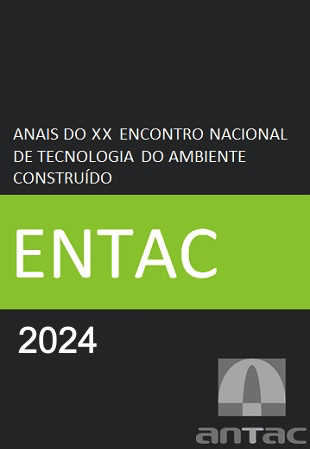Factors that determine the strategic positioning for construction companies in the context of Construction 4.0
DOI:
https://doi.org/10.46421/entac.v20i1.6273Keywords:
Construction 4.0. Industry 4.0. Strategic. Planning. Positioning.Abstract
The digitization and industrialization of processes associated with Construction 4.0 enables benefits such as enhanced productivity and efficiency in the construction sector. Furthermore, the success of construction companies is related to their strategies for providing greater value to the market. While existing literature describes the characteristics of Construction 4.0, little is known about the aspects related to the strategic competition among companies in this new paradigm of industry transformation. Hence, the objective is to ascertain the factors that determine the strategic positioning of construction companies within the context of Construction 4.0. In order to achieve this, concepts pertaining to Construction 4.0 were analyzed and categorized based on academic literature and market research. The findings reveal that these factors are associated with internal aspects of the company, such as resources, capabilities, organizational structure, and corporate strategies, as well as external aspects such as analysis of industry dynamics and monitoring of legislation and regulations. These factors reflect the market characteristics that activate the internal capabilities of Construction 4.0 and enable the formulation of strategic positioning for companies involved in this type of construction. As a contribution, this study advances the description of these characteristics and factors related to the strategic positioning of companies linked to Construction 4.0.
References
FORCAEL E, FERRARI I, OPAZO-VEGA A, PULIDO-ARCAS JA. Construction 4.0: A Literature Review. Sustainability 2020;12:9755. https://doi.org/10.3390/su12229755.
CRAVEIRO F, DUARTE JP, BARTOLO H, BARTOLO PJ. Additive manufacturing as an enabling technology for digital construction: A perspective on Construction 4.0. Automation in Construction 2019;103:251–67. https://doi.org/10.1016/j.autcon.2019.03.011.
SAWHNEY A, RILEY M, IRIZARRY J. Construction 4.0: An Innovation Platform for the Built Environment. Routledge; 2020. https://doi.org/10.1201/9780429398100.
MUÑOZ-LA RIVERA F, MORA-SERRANO J, VALERO I, OÑATE E. Methodological-Technological Framework for Construction 4.0. Arch Computat Methods Eng 2021;28:689–711. https://doi.org/10.1007/s11831-020-09455-9.
PORTER ME, HEPPELMANN JE. How Smart, Connected Products Are Transforming Competition. Harvard Business Review 2014;92:64–88.
HOFFMAN NP. An Examination of the “Sustainable Competitive Advantage” Concept: Past, Present, and Future. AMSR 2000;4:16.
BARNEY J. Firm Resources and Sustained Competitive Advantage. Journal of Management 1991;17:99–120. https://doi.org/10.1177/014920639101700108.
KRAKOWSKI S, LUGER J, RAISCH S. Artificial intelligence and the changing sources of competitive advantage. Strategic Management Journal 2022;n/a. https://doi.org/10.1002/smj.3387.
MARCON É, SOLIMAN M, GERSTLBERGER W, FRANK AG. Sociotechnical factors and Industry 4.0: an integrative perspective for the adoption of smart manufacturing technologies. Journal of Manufacturing Technology Management 2021;ahead-of-print. https://doi.org/10.1108/JMTM-01-2021-0017.
SCHNEIDER P. Managerial challenges of Industry 4.0: an empirically backed research agenda for a nascent field. Rev Manag Sci 2018;12:803–48. https://doi.org/10.1007/s11846-018-0283-2.
PATTON MQ. Qualitative evaluation and research methods (2nd ed.). Thousand Oaks, CA, US: Sage Publications, Inc; 1990.
ARORA N, BATRA G, TEULIERES M, VARANASI S, WONG T. Construction and building technology: Poised for a breakthrough? McKinsey & Company. McKinsey 2020. https://www.mckinsey.com/industries/advanced-electronics/our-insights/construction-and-building-technology-poised-for-a-breakthrough (accessed September 10, 2021).
PAN M, PAN W. Stakeholder Perceptions of the Future Application of Construction Robots for Buildings in a Dialectical System Framework. Journal of Management in Engineering 2020;36:04020080. https://doi.org/10.1061/(ASCE)ME.1943-5479.0000846.
AHMED V, AZIZ Z, TEZEL A, RIAZ Z. Challenges and drivers for data mining in the AEC sector. Eng, Const and Arch Man 2018;25:1436–53. https://doi.org/10.1108/ECAM-01-2018-0035.
LAVIKKA R, KALLIO J, CASEY T, AIRAKSINEN M. Digital disruption of the AEC industry: technology-oriented scenarios for possible future development paths. Construction Management and Economics 2018;36:635–50. https://doi.org/10.1080/01446193.2018.1476729.
JIANG R, MAO C, HOU L, WU C, TAN J. A SWOT analysis for promoting off-site construction under the backdrop of China’s new urbanisation. Journal of Cleaner Production 2018;173:225–34. https://doi.org/10.1016/j.jclepro.2017.06.147.
MINTZBERG H. The Fall and Rise of Strategic Planning. Harvard Business Review 1994.
SHIRAZI B, LANGFORD DA, ROWLINSON SM. Organizational structures in the construction industry. Construction Management and Economics 1996;14:199–212. https://doi.org/10.1080/014461996373467.
PELLICER E, YEPES V, CORREA CL, ALARCÓN LF. Model for Systematic Innovation in Construction Companies. Journal of Construction Engineering and Management 2014;140:B4014001. https://doi.org/10.1061/(ASCE)CO.1943-7862.0000700.
RAMAGE M. Construction Industry Trends That Define the Next Normal. Trimble 2020.
DE ALMEIDA PR, SOLAS MZ. Shaping the future of construction: A Breakthrough in Mindset and Technology. World Economic Forum; 2016.
RIBEIRINHO MJ, MISCHKE J, STRUBE G, SJÖDIN E, ANDERSON T, BLANCO JL, et al. The next normal in construction: How disruption is reshaping the world’s largest ecosystem. McKinsey & Company; 2020.
SCHWAB K, ZAHIDI S. The Future of Jobs Report 2020. World Economic Forum; 2020.
ARMSTRONG G, GILGE C, MAX K. Future-Ready Index: Leaders and followers in the engineering & construction industry. KPMG International; 2019.
FORSYTH L. Modernizing government: Global trends. KPMG International; 2021.
PORTER ME. How Competitive Forces Shape Strategy. Harvard Business Review 1979.
BURTONSHAW-GUNN SA, editor. The Essential Management Toolbox: Tools, Models and Notes for Managers and Consultants. Hoboken, NJ, USA: John Wiley & Sons, Inc.; 2008. https://doi.org/10.1002/9781119208723.
PAN W, ARIF M. Manufactured construction: Revisiting the construction-manufacturing relations. Procs 27th Annual ARCOM Conference, Bristol, UK: Association of Researchers in Construction Management - ARCOM; 2011, p. 105–14.
KOLAGAR M, PARIDA V, SJÖDIN D. Ecosystem transformation for digital servitization: A systematic review, integrative framework, and future research agenda. Journal of Business Research 2022;146:176–200. https://doi.org/10.1016/j.jbusres.2022.03.067.
BRITO JTS. Caracterização dos serviços 4.0 na construção civil. São Paulo: Escola Politécnica - Departamento de Engenharia de Construção Civil; 2021.
BRITO JTS, CARDOSO FF, OVIEDO-HAITO RJJ. A servitization profile of the Construction 4.0. Proceedings CIB World Building Congress 2022, Melbourne, Australia: CIB - International Council for Research and Innovation in Building and Construction; 2022, p. 10.
MAGRETTA J. Entendendo Michael Porter. O Guia Essencial da Competição e Estratégia. 1a edição. São Paulo: HSM Editora; 2012.
KOHTAMÄKI M, RABETINO R, PARIDA V, SJÖDIN D, HENNEBERG S. Managing digital servitization toward smart solutions: Framing the connections between technologies, business models, and ecosystems. Industrial Marketing Management 2022;105:253–67. https://doi.org/10.1016/j.indmarman.2022.06.010.
CRNJAC M, VEŽA I. From Concept to the Introduction of Industry 4.0. International Journal of Industrial Engineering and Management (IJIEM) 2017; 8:21–30. https://doi.org/10.24867/IJIEM-2017-1-103.

